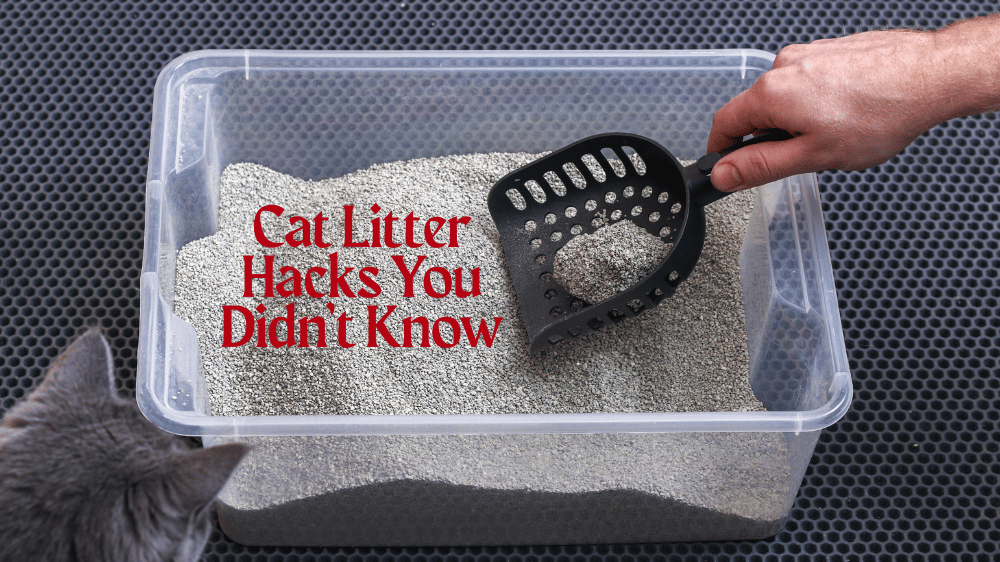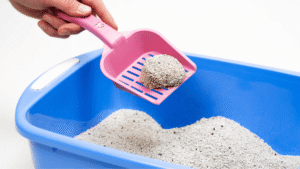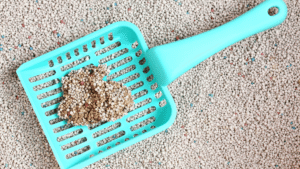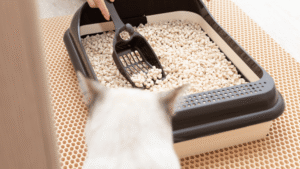Selecting the right “Cat litter” is key to ensuring your cat stays happy and “your home stays clean. If you’re having the same issues with the odor of your space being overcast or looking for the perfect litter for your furry friend then worry not – you are certainly not alone!
In this post, we’ll share some of the best “hacks” to keep your cat’s litter box tidy and fresh. From odor to texture to clumping ability, the perfect cat litter can take all the mess and stress out of the litter box and leave both you and your cat feeling better.
Why Cat Litter Matters: Understanding Its Role in Pet Health
When it comes to maintaining a clean, odor-free home, cat litter is an important topic. The perfect litter is not only to keep clean, but also let the cats feel good! Since there are a lot of them, it’s necessary that we know at least some of the best cat litter types for your cat’s health and a little peace of mind.
For instance, clumping cat litter is best for odor control and convenience, while “non-clumping” is best for cats with sensitive paws.
If you prefer eco-friendly options, sustainable cat litter options that include recycled paper or wood pellets can reduce your impact on the environment. But regardless of which type you opt for, maintenance is crucial if you want to keep things fresh and hygienic.
Yet there’s another byproduct of your choice of cat litter that’s just as important, and that’s how it affects your cat’s health. And the wrong litter can cause respiratory problems for your pet, or even skin irritation if it is too dusty.
That’s where the low dust cat litter comes in, providing a more breathable option so the cats aren’t inhaling so much dust and dirt, which is actually really beneficial in preventing respiratory issues, especially if you have cats with allergies or asthma.
Cat Litter Hacks for Odor-Free Homes
Maintaining a cat litter that doesn’t smell is one of the number one problems that challenges cat owners. But fortunately, with the right strategies and materials, you can safely create a space that’s not only fresh and pleasant for you, but is also encouraging safe and comfortable behavior from your cat. These are a few odorless cat litter hacks to help keep your place smelling fresh:
Layer Your Litter Properly:
The secret to controlling odors begins with proper layering of your litter. Begin by pouring a thin layer of odor-free cat litter, made to absorb moisture and odors fast. Finally, cover it with your favorite clumping or “non-clumping” (see: scoopable) litter. This is an odor blocking barrier that works!
Add Natural Odor Absorbers:
There are natural, easy things you can do to help absorb the odors your cat litter is generating, improving its efficiency. A little bit of baking soda poured on the litter just before the top layer is added can neutralize odors without harsh chemicals.
Another great choice is activated charcoal which is a great odor absorber. Simply divide a small pouch of activated charcoal among the bottom of the litter box for extra freshness.
Keep Clean Litter Box Clean the Litter Box Every Now And Then:
Cat litter box maintenance is another “must” if you want to keep odors under control. Scoop your litter box at least daily, to remove waste and to keep pet odors down.
Periodic cleaning the box itself, at least once a week, will ensure that the sides do not absorb odors that could linger. Clean the box with mild soap and water, and then make sure it’s completely dry before refilling with fresh litter.
Use Low Dust Litter:
If you’re concerned about dust impacting both your cat’s lungs and the smell in your house, low dust cat litter is a great choice. It reduces fine particles that can get lodged in the air, and is also quite good at controlling odors. Low dust cat litter also means less mess from tracking, keeping your floors cleaner.
Invest In A Proper Litter Box:
You may consider upgrading to a litter box with a lid to hold in odors. For those of you with two or more cats, or even a high quality covered litter box, can contain smells and make sure cat litter box maintenance is easier.
Table: Best Cat Litter Brands for Odor Control
| Brand | Type of Litter | Odor Control | Best For |
| Brand A |
Clumping |
Excellent |
Multiple cats |
| Brand B |
Non-Clumping |
Good |
Single cats |
| Brand C |
Natural |
Moderate |
Sensitive cats |
| Brand D |
Crystal |
Very Good |
Odor control focus |
These simple yet effective cat litter hacks can transform your experience with “cat litter”, ensuring your home stays fresh and your cat remains happy.
By layering your litter correctly, incorporating natural odor-absorbing solutions like baking soda or activated charcoal, and keeping up with regular cat litter box maintenance, you’ll enjoy a cleaner, more odor-free environment.
Top Cat Litter Types You Should Consider
All cat litters are not equal and knowing the best cat litter types for your cat is KEY to long-term success. Clumping cat litter is a favorite for many cat owners, due to how easy it is to clean and its ability to control odors.
It clumps solid when wet, allowing you to scoop waste from the clumps without changing the whole box. But it does have dust, which may not be great for cats with respiratory issues. For a low-dust option, give low dust cat litter a shot, it is easier on your cat’s lungs and better for sensitive pets.
If you want something environmentally friendly, sustainable cat litter options like recycled paper, wood pellets or another type of corn-based litter are good. These are biodegradable litters, and are thus an eco-friendly choice.
For kittens, you might want to look for the best cat litter for kittens—something that won’t irritate their little paws but will absorb moisture and get rid of unpleasant scent. Non-clumping litters may be a better option for very small ones until they are well house trained.
How to Make Your Cat Litter Last Longer
One of the easiest ways to save money, while also making sure your cat’s litter box never smells, is to use less cat litter. If you don’t maintain and keep your litter clean, not only will your cat end up agitated, but you’re also needlessly wasting scarce commodities. Here are some practical cat litter cleaning tips to help you get the most life of your litter:
Rotate the Litter:
Instead of changing your cat litter all the time, you can move it for a few days, let’s say. That is by mixing in old with new litter, which helps it last longer, but still work as a odor-eliminator.
How you layer the litter can also have an impact on getting the most out of it. You can reduce the amount of waste and keep your cat’s box cleaner by adding a layer of fresh litter over the top of the used litter.
Scoop Regularly:
One of the most effective hacks involves daily scooping of your “cat litter.” Changing your cat litter often keeps it from being pushed into the litter and losing its effectiveness.
Cat litter cleaning tips say that if you are scooping often, once every several weeks (instead of once every week) the litter will need to be replaced.
Add Fresh Litter Sparingly:
Avoid adding a significant amount of new litter at once when doing a litter top up in the litter box. There’s no need to significantly increase it; just add a little bit to even it up to the right level. Stuffing the box too full makes it difficult to clean, awkward to use and can result in more waste.
Use a Liner for Easy Cleanup:
It’s also beneficial to use a litter liner, which makes cleanup easier and helps to prolong the life of your box. This little trick will cut down on how much litter is sticking to the sides of the box, and make it easier to clean and maintain.
Sustainable Cat Litter Options That Are Better for the Environment
If you’re seeking the best sustainable litter options, or cat litters that are gentler on the planet, there are a number of eco-friendly options — or, in other words, litters made of biodegradable materials — to choose from.
Not only will these alternatives keep your home smelling fresh, but they’ll also shrink your carbon footprint. Below are some of the best sustainable choices:
Wood Pellet Litter:
Compressed wood pellet litter is a biodegradable, largely renewable option that breaks down naturally. It’s a great sustainable cat litter option for anyone wanting to spend less, reduce waste and help eco-friendly practices.
Corn-Based Litter:
Corn-based litter is another common biodegradable option. It’s derived from corn kernels and is super absorbent, clumping up nice and tight to help make cleaning time that much easier. It’s also compostable and doesn’t have harmful chemicals, so it’s easier on the environment.
Recycled Paper Litter:
Litter made from recycled paper is an eco-friendly alternative to the conventionally used clay-based litters. It’s gentle to sensitive paws and is suitable for cats with allergies, but it’s also biodegradable and compostable.
Coconut-Based Litter:
Another environmentally friendly option is coconut-based litter, which is crafted from the husks of coconuts. That is why it has become known as the “hip bag.”
It is to promote a more self-aware lifestyle, and convenient to carry out. And, it’s sustainable and natural to boot, providing a safe alternative for your cat and the environment.
Grass Seed Litter:
A newer alternative on the market is grass seed litter, which uses grass seeds to produce an absorbent and biodegradable product. It’s easy on your cat’s paws, controls odors naturally and is 100% compostable.
Litter Box Tips for Multiple Cats
Dealing with a litter box for multiple cats can be a challenge, but, with the right techniques, it’s absolutely possible to keep things clean and fresh. Below are some key litter box tips for multiple cats to keep an odorless home and happy cats.
One Box Per Cat (Plus One):
The golden rule for multiple cat households is one litter box per cat, plus one. So, with three cats, you will want four litter boxes. This decreases overcrowding of the boxes, the stress and increases the level of hygienic conditions for each cat.
Proper Placement of Boxes:
Location is everything when it comes to litter boxes. Try to put them in quiet, low-traffic places where your cats feel safe and secure. Keep the boxes away from food or water dishes — cats generally don’t like to eliminate where they eat.
Use High-Quality Litter:
High-quality litter, which helps to control odor, is key for multi cat households. You might want to use clumping litter or crystal litter. Two of them do a better job at odor control and are easier to clean. And low dust cat litter is better for keeping your pets free of lung-tangling litter dust, particularly in multi cat households.
Regular Cleaning is a Must:
Cat litter box maintenance is even more crucial with multiple cats. Keep waste hauled off and the area fresh by scooping the boxes at least one or two times each day. Clean the box once a week, and change the litter as necessary.
Consider Litter Box Liners:
There are many options for litter box liners and using one can make cleanup easier, especially if you have multiple boxes to clean. They keep litter from sticking to the box, which means less cleanup time and a longer lasting box.
By following these litter box tips for multiple cats you are able to keep your home smelling fresh and reduce stress between pets, ensuring that each cat has a clean space to take care of business.
DIY Cat Litter Disposal: Easy and Eco-Friendly Ideas
Appropriate litter disposal is important for both your cat and the environment. Cat litter can cause a lot of harm if disposed of improperly, yet there are a number of eco-friendly ways to deal with your cat’s waste. Here are some low-waste, eco-friendly litter disposal ideas to reduce our environmental impact:
Composting Cat Litter:
Do you realize that some cat litter can be composted? And biodegradable litters — such as varieties made from recycled paper, wood pellets or corn-based products — can be composted in your yard or garden.
Not all “cat litter” is compostable, but many natural kinds decompose over time and add nutrients to your soil. Do read the label to know if your selected litter is compostable.
Use Biodegradable Bags:
One of the simplest ways to get rid of “cat litter” is through biodegradable bags. In place of plastic bags, consider using biodegradable bags made from plant-based substances.
These bags degrade more than regular plastic garbage bags, decreasing the overall damage caused to the environment. They’re a great pick for eco-friendly pet owners who are already doing their part, and who want to cut down on their litter footprint.
Litter Composting Systems:
Purchase a litter composting system to manage cat litter garbage in a safe, sanitary way. They are for dealing with biodegradable cat litter – a convenient way for trash and the proper decomposition. They facilitate the cleanliness of your litter box surrounding and prevent from constantly bagging and throwing away waste.
Flushable Cat Litter:
If you’re lucky enough to have a septic system, consider flushable cat litter. Created from all-natural ingredients such as wheat or corn, these varieties of “cat litter” are intended to be flushed down the toilet, making disposal fast and easy. And don’t forget to make sure that your local plumbing system can accommodate flushable “cat litter” to help prevent any plumbing problems.
Biodegradable Litter Box Liners:
Or, if you don’t like the idea of composting or flushing, try eco-friendly litter box liners that are made from compostable materials. These liners not only make cleaning the litter box easier.
But they also extend the life of the liner itself by being biodegradable (and don’t worry, they hold up long enough for you to get plenty of use out of it). Sustainable cat “litter” disposal with eco-friendly materials is a small, simple move you can make.
With these cat litter disposal ideas, you’ll do your part to keep the environment a safer and cleaner place while enjoying a fresh, neat and odor-free home. Opting for biodegradable, compostable cat litter will help minimize the amount we fill landfills and add one small step to a less wasteful life for you, and your furry housemate.
Best Cat Litter for Kittens: What You Need to Know
The best cat litter is important to select when it comes to caring for your kitten. Kittens have sensitive pads on their paws, so choose a cat litter that is gentle but effective. Here’s what you need to know about the best cat litter for kittens:
Soft, Non-Toxic Options:
Kittens are curious by nature and will often begin to explore their cat litter with their paws and sometimes their mouths. This is why it’s important to select a soft, non-toxic cat litter that will not irritate their skin or otherwise harm your cat for eating some of it.
Opt for biodegradable or natural litters made with recycled paper, corn or wood. They are more gentle on their paws and safe for little ones who could accidentally lick or nibble the cat litter.
Clumping vs. Non-Clumping Litter:
Clumping cat litter is normally used for adult cats, but it is not advisable for kittens less than 8 weeks old since they may accidentally eat the cat litter.
Non-clumping litters, for example wood, or paper, is a safer choice for them while they are in their first stages of life. This option is softer and less likely to create any digestive problems should your dog accidentally eat it.
Variety of Absorbent and Odor Control:
Although kittens may still be learning to use their litter box, they can create odor that requires solid odor control. Use an absorbent silicone gel non-clumping or clumping cat litter that soaks up liquids and reduces odor.
You can choose from those that specify online that they are safe for kittens and good at masking smell or have natural odor-absorbing properties, like litters made from corn or wheat that can be effective at controlling smell.
When to Switch Your Kitten to New Litter:
As your kitten grows, you might want to move them from a softer, non-clumping “cat litter” to clumping litter that’s more absorbent. It should be a slow operation so as not to unsettle your kitten.
Begin by mixing a small portion of the new cat litter with the old litter, then raise the amount over a few days. This will help them get used to the new texture and also to help prevent them from beginning to avoid the litter box.
Keep the Litter Box Clean:
Kittens are especially sensitive to dirty litter boxes compared to adult cats. Remember to get the waste out of there once a day, and refresh the cat litter. Help your kitten learn good bathroom manners with a clean litter box and fresh litter.
With the help of these pointers and some of the best cat litter for kittens you can ensure a cozy, secure atmosphere for your small feline pal. As you can see, choosing the right cat litter is going to keep your kitty’s feet soft, and also aid their litter training, which will make your life as a cat owner so much more convenient.
Conclusion:
To sum it up, it’s important to choose the best possible cat litter so that you can provide a clean, fresh and more comfortable and pleasant environment for you and your cat. Whether you’re trying out litter hacks or exploring sustainable cat litter options, or just looking at cat litter cleaning tips, it is important to find the one that suits the best for your pet.
And don’t forget, litter box maintenance is important to maintaining a house that smells fresh and a cat that is staying healthy. With the proper litter, and regular care, you can help keep your cats paws clean and your house smelling fresh.
FAQs:
What kind of cat litter is the best for odor control?
The best cat litter for odor control is, to a large extent, dependent on you and your cat’s preferences. When it comes to litter that offers the best in odor control, clumping cat litter is usually the first option that comes to mind, as clumping litter is able to capture both odors and moisture. I also swear by crystal cat litter – it has epically good absorbency and odor control.
If you have budget constraints, non-clumping litters can be good for odor control as well, but expect to clean the box more often (one to two times per week). Always make sure that you choose cat litter that is made to prevent odors and smell.
How frequently should I change my cat’s litter box?
As a rule of thumb, you should change your cat litter at least one time per 1-2 weeks, depending on how many cats use the litter box. But to keep it as clean as you can, you should really be scooping the box at least daily.
After all, litter cleaning advice says that if you scoop every day, it’s not until two weeks later that you really need to do a full switch to keep your litter as fresh as possible and any lingering scents at bay.
Here’s a basic guideline:
Daily: Remove waste and stir up the litter.
Weekly: You’ll clear all the used litter and add clean new litter.
1-2 weeks: The litter box should be washed with soap and warm water, then dried.
Which cat litter (clumping vs non-clumping) is good for multi cat household?
Clumping cat litters are often a better choice if you have more than one cat in your home. Clumping litter forms solid clumps that allow you to easily scoop up the source of odors and litter without making a mess – no more spilled litter to clean up.
It also keeps things cleaner, and gives you a good Idea of which places have to have the most attention. That said, some cats or kittens who are especially sensitive may prefer non-clumping cat litter, because it’s gentler on their paws.
Litter box recommendations for many cats are:
Many boxes: Give each cat a box and one extra.
Clumping litter: Best way to control odors in household with multiple cats.
Scoop frequently: You’ll have to clean the box several times a day if you have multiple cats.
Can I use any other natural cat litter substitutes?
Yes! There are a number of environmentally friendly and effective cat litters. The best natural alternatives include biodegradable litters made from corn, wheat or wood pellets. They offer stellar odor control and respect the environment.
There are a few popular sustainable cat litter options:
Corn litter: Biodegradable and naturally absorbent.
Wood pellet litter: It’s made from compressed wood and is compostable.
Recycled paper litter: Earth-friendly and soft with good absorption.
These substitutes are all eco-friendly and are great for being a natural, non-chemical alternative for your cat’s litter box.
How Do I Control Litter Box Smell?
To ensure that the cat litter’s odors are kept in check, you can practice these easy and effective methods found in these 9 odor-free cat litter life hacks:
Scoop daily: Clean your waste out at least once a day to control odors.
Sprinkle in baking soda: Baking soda is another great odor neutralizer, simply sprinkle a little into the cat litter.
Use low dust cat litter: Opt for a low dust litter, to preserve the air quality of your home while still being effective at controlling odors.
You might also want to try clumping or crystal cat litter, as they are both very effective at odor control and are easy to clean.







